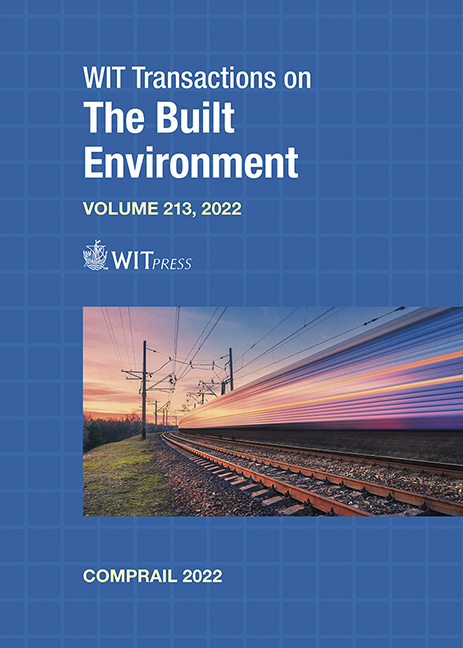COMPUTER SIMULATION TO PREDICT THE SLIDING WEAR OF PEARLITIC RAILS IN CONTACT BETWEEN CAST AND FORGED RAILWAY WHEELS
Price
Free (open access)
Transaction
Volume
213
Pages
10
Page Range
89 - 98
Published
2022
Paper DOI
10.2495/CR220081
Copyright
Author(s)
JOÃO V.R. SILVA E SILVA, LUIZ F.V. CORRÊA, RUBSON M. CAMPOREZ, CHERLIO SCANDIAN, GUILHERME F. M. DOS SANTOS
Abstract
This work aims to implement and evaluate the effectiveness of the semi-analytical computational method global incremental wear model (GIWM) in predicting the sliding wear of rails in contact with the flange of railway wheels during curves, which is a parameter of great importance for the efficiency of railway operation. The method validation was performed by comparing the wear depth calculated using the GIWM algorithm to the experimental results published in previous work. The data was obtained in dry (relative humidity: 55% ± 10%) pin-on-disc tests carried out on a universal PLINT TE67 tribometer under a normal load of 24.6 N, representing 1.5 GPa of contact pressure. The specimens, hemispherical pins, were extracted from a pearlitic steel rail and the discs were extracted from two different, forged and cast, Class C railway wheels. The tangential sliding speeds were 0.1 m/s and 0.9 m/s, the latter being the most representative according to the literature. The wear model was based on Archard’s law for sliding wear and the algorithm was implemented in Python. The results showed good agreement of the wear depth values between the computational and experimental methods for the cast wheel material under higher sliding speed, partial agreement for both wheel materials at lower speed and inconsistency for the forged wheel material under higher sliding speed. Furthermore, the algorithm is computationally efficient, presenting simulation time up to 180 times less than the finite element methods reported in the literature. Therefore, it was concluded that the GIWM method has potential for application in the freight railway sector, which uses cast wheels extensively, to guide technical areas regarding the wear behavior of rails under sliding contact during curves.
Keywords
tribology, railway, sliding wear, Archard, computer simulation, GIWM





